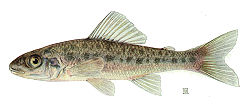| Acanthomorpha Temporal range: | |
|---|---|
 | |
| Trout-perch (P. omiscomaycus) | |
| Scientific classification | |
| Kingdom: | Animalia |
| Phylum: | Chordata |
| Class: | Actinopterygii |
| Clade: | Ctenosquamata |
| Clade: | Acanthomorpha Rosen, 1973 [2] |
| Subdivisions | |
| |
Acanthomorpha (meaning "thorn-shaped") is an extraordinarily diverse taxon of teleost fishes with spiny fin rays. The clade contains about one-third of the world's modern species of vertebrates: over 14,000 species. [3]
Contents
A key anatomical innovation in acanthomorphs is hollow and unsegmented spines at the anterior edge of the dorsal and anal fins. [4] A fish can extend these sharp bony spines to protect itself from predators, but can also retract them to decrease drag when swimming. [5] Another shared feature is a particular rostral cartilage, associated with ligaments attached to the rostrum and premaxilla, that enables the fish to protrude its jaws considerably to catch food. [6]
Rosen coined the name in 1973 to describe a clade comprising Acanthopterygii, Paracanthopterygii, and also ctenothrissiform fossils from the Cretaceous Period, such as Aulolepis and Ctenothrissa. Those fossils share several details of the skeleton, and especially of the skull, with modern acanthomorphs. [2] Originally based on anatomy, Acanthomorpha has been borne out by more recent molecular analyses. [7]
The oldest acanthomorphs were initially reported by Louis Agassiz from the Cenomanian Sannine Formation of Lebanon, and were considered as such for over a century until slightly older remains were identified from the end-Albian of Mexico. Early acanthomorph fossils are diverse and well-preserved in formations from the early part of the Late Cretaceous from the Cenomanian to the Campanian, but become exceedingly rare throughout the Maastrichtian and the Paleocene (spanning the likely origins of a number of modern taxa) before a second explosion in fossil abundance and diversity in the Eocene. This mysterious gap is known as "Patterson's Gap" after paleontologist Colin Patterson, who first identified it in 1993. [1]